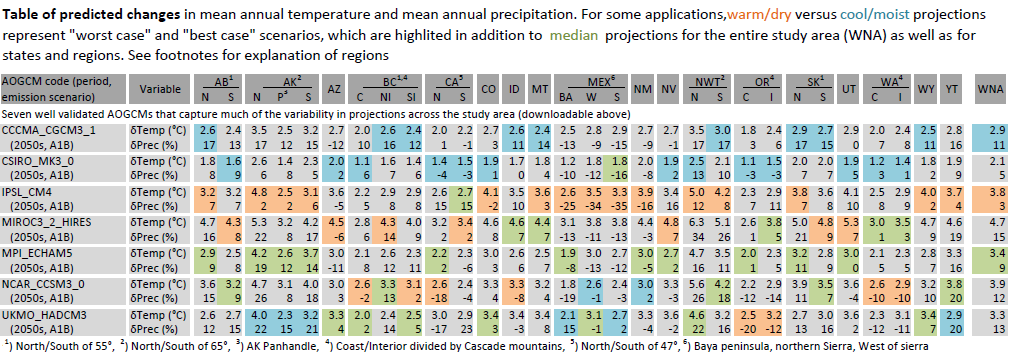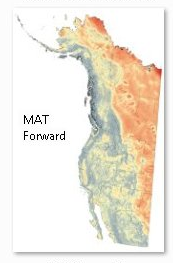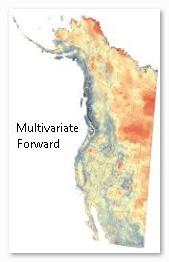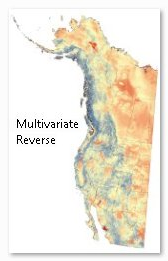This dataset has been prepared for the Climate Adaptation Conservation Planning Database for Western North America (CACPD) project, funded by the Wilburforce Foundation with additional contributions from the GenomeCanada AdapTree project. It is based on Parameter Regression of Independent Slopes Model (PRISM) climate data for the 1961-1990 normal period (see http://tinyurl.com/ClimateWNA), and climate change projections of the Coupled Model Intercomparison Project phase 3 (CMIP3) database corresponding to the 4th IPCC Assessment Report for future projections.
The velocity of climate change is an elegant analytical concept that can be used to evaluate the exposure of organisms to climate change. In essence, one divides the rate of climate change by the rate of spatial climate variability to obtain a speed at which species must migrate over the surface of the earth to maintain constant climate conditions. Here, we provide data from an improved algorithm that conforms to standard velocity calculations if climate equivalents are nearby. Otherwise, the algorithm extends the search for climate refugia globally. Below we provide velocity surfaces for mean annual temperature (MAT) as well as a multivariate PCA implementation that searches for climate matches in 12 biologically relevant climate variables.
Futher we distinguish, forward and backward velocities allowing useful inferences about conservation of species (present-to-future velocities) and management of species populations (future-to-present velocities). For the forward calculation we ask: what is the rate at which an organism in the current landscape has to migrate to maintain constant climate conditions? Conversely, in the reverse calculation we ask: given the projected future climate habitat of a grid cell, what is the minimum rate of migration for an organism from equivalent climate conditions to colonize this climate habitat? For more information see:
Download links for gridded data (1km resolution)
The gridded climate layers downloadable below are in Lambert Conformal Conic projection, at 1km resolution, and covering North America, west of 100° longitude. The database consists of ESRI grids, a native format of ArcGIS software, but compatible with many other GIS applications.
Note that these are older datasets hosted on a non-encrypted server, which triggers a security warning. The Chrome browser blocks the download links entirely, but you can use Microsoft Edge or Firefox to still download these files if you wish. Follow the > or ... link next to the security warning, then choose "allow download" or "download anyway".
2) 2020s: average for years 2011-2040, 2050s: 2041-2070, 2080s: 2071-2100.
3) 7 AOGCMs selected based on the table and graph below.

How to select future climate scenarios
Selecting scenarios for climate change impact and adaptation research is a complex task. Not all future projections have equal resolution, number of runs, and validation statistics against past climate. We selected a representative set of 7 AOGCMs from 14 high-quality models, from a total of 23 CMIP3 AOGCMs. To further whittle the number of AOGCMs under consideration down, researchers often select "worst case", "best case", and "median" climate change projections. However, what constitutes a worst case or best case scenario, differs by region and by the climate variable of interest.
The plot on the right may help with scenario selection for the entire study area, and the table below for scenario selection for regions within western North America. We also provide ensemble scenarios for download above, but they may have unrealistic combinations of individual climate variables.





